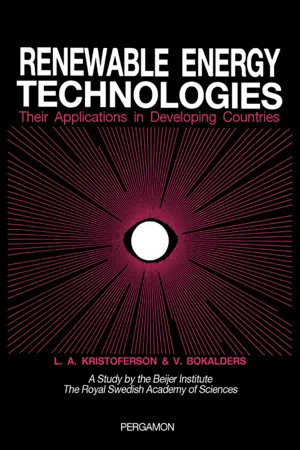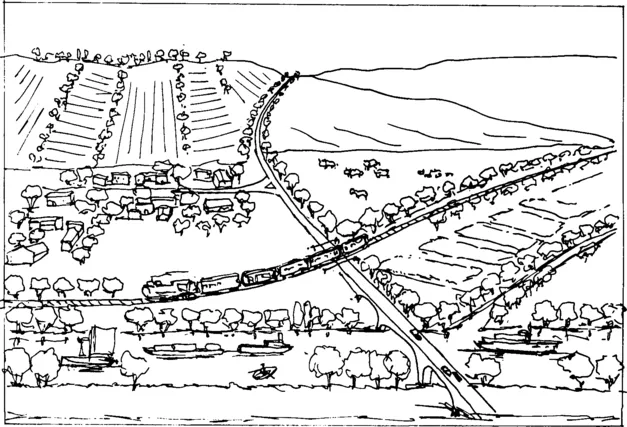![]()
Section I
BIOENERGY: PRODUCTION, CONVERSION, UTILIZATION
Outline
Chapter 1: FUELWOOD: FORESTRY & AGROFORESTRY
Chapter 2: ENERGY CROPS
Chapter 3: AGRICULTURAL RESIDUES AND ORGANIC WASTES
Chapter 4: PEAT
Chapter 5: BRIQUETTING OF BIOMASS
Chapter 6: CHARCOAL PRODUCTION
Chapter 7: WOOD AND CHARCOAL STOVES
Chapter 8: BIOMASS COMBUSTION IN SMALL-SCALE INDUSTRY
Chapter 9: BIOGAS
Chapter 10: DRAUGHT ANIMAL POWER
![]()
1
FUELWOOD: FORESTRY & AGROFORESTRY
Publisher Summary
This chapter discusses the importance of forestry and agroforestry for fuelwoods. Forest and biomass resources are often seen as fuels of poor rural dwellers in the Third World. Increasingly, however, these fuels are preferred even in high-income households in developing countries because supplies can be guaranteed. Additionally, fuelwood is increasingly used in the commercial sector, particularly, for curing tobacco and tea, and in industry. It is also often used in processed forms, such as charcoal, distillates, and gas. The chapter also discusses that careful planning must be done if conventional forestry is to provide part of the future fuel requirements. Moreover, particular attention needs to be paid, within the wood monoculture systems to obtaining a sustained off-take from the forest throughout the crop cycle. A well-conceived agroforestry intervention can achieve an increased production of wood and at the same time address many of the problems related to land productivity and sustainability.
Introduction
Until recently firewood and other plant fuels have been a prime source of energy for people. Industrialization used additional sources also, first wind and water power, then hydrocarbons to provide mechanical energy. While fossil fuels, themselves of organic origin, presently run most of the industrialized world, firewood is still the main source of domestic energy in most non-industrialized countries. Wood for energy also seems to be making a comeback in the industrialized world, being a conditionally renewable resource produced within the country of consumption in contrast to imported fossil fuels.
Only in the last decade has the role of fuelwood been fully recognised. Despite this recognition estimates of the production and consumption of fuelwood remain crude. On a global scale, fuelwood and other biomass account for some 15% of total energy consumption. In contrast, the cumulative share of hydro and nuclear power is six times smaller. In developing countries, biomass is the predominant fuel accounting for 43% of total energy consumption. But even in developed countries, fuelwood accounts for a significant proportion of the energy budget. The potential of fuelwood as a renewable energy resource is not recognised largely because market mechanisms currently undervalue the benefits obtained from renewable energy. The potential of forest energy resources can be gauged by comparing these resources with global hydro-electric potential; the estimated annual energy increment from designated forest areas is five times the capacity of the world’s hydro-electric potential.
Forest and biomass resources are often seen as the fuels of poor rural dwellers in the Third World. Increasingly, however, these fuels are the urban fuels preferred even in high income households in developing countries because supplies can be guaranteed. Additionally, fuelwood is increasingly used in the commercial sector, particularly for curing tobacco and tea, and in industry. It is also often used in processed forms such as charcoal, distillates and gas.
A number of developed countries derive a considerable proportion of their energy consumption from fuelwood: Sweden obtains 14% of its energy requirement, Canada 8% and Australia 3%. In the United States over 4%
The Chinese “Four round-abouts”: trees around houses and along roads, railways and channels.
of the total energy consumption is derived from fuelwood and several million households depend on fuelwood for domestic heating.
In many developing countries and in remoter areas of the developed world, wood is frequently the cheapest available fuel not only per unit weight but also per unit of heat. No special facilities are required for wood storage and, in addition, it is perfectly safe to store the energy supplies for long periods. When dried, fuelwood burns safely, although, with the latest technologies skilled labour is frequently required for efficient operation. Wood-fuelled power stations are also feasible, even utilizing advanced technologies like fluidised bed combustion.
Careful planning must be done if conventional forestry is to provide part of the future fuel requirements. Particular attention has to be paid, within the wood monoculture systems to obtaining a sustained off-take from the forest throughout the crop cycle. Above all, the low priority which is accorded to conventional fuelwood production, a low priority that is mirrored by the lack of investment, should be reversed. There is no reason why the criteria, if not the actual methods applied to forest production for poles and industrial feedstock cannot be applied to forestry production for energy.
Firewood and Charcoal Consumption: Use and Prospects
The estimated firewood consumption in the Third World in 1950 was 1.5 billion m3, which was some 83% of total timber use in these areas, and about 90% of all firewood used in the world. The amount has increased by 26% over ten years, which keeps pace with the 25% growth in population during the same period. The total growth of the world’s tropical forests is between 10 and 20 billion m3/yr. In theory this is more than enough production capacity, but, in reality, the supply is extremely uneven, and in vast areas firewood shortages are growing alarmingly. This is because forests per se are rarely used for energy - trees outside the forest are the principal source of fuelwood, although charcoal is often made from larger scale clear-cutting, particularly close to urban markets.
Figures on the magnitudes and trends of fuelwood supply and demand are of such an alarming character that most international agencies have given urgent priority to the problems. For example, in a recent study of 15 developing countries, FAO found that the present rate of fuelwood plantation establishment would have to be increased by more than 10 times to 70 000 hectares per year to avoid predicted shortages at the turn of the century.
The world’s tropical forests and woodlands are currently being destroyed at an alarming rate. Of 1.2 × billion ha of closed forest and 0.7 billion ha of open woodland, making up 40% of the total tropical land mass, the area felled yearly is estimated to be 7.5 million ha and 3.8 million ha respectively, or an annual regression rate of 0.58%. In individual countries this rate can be much higher, e.g. 4.44% in the Ivory Coast or 2.73% in Costa Rica. Some of this area (possibly one third) regenerates to secondary forest or bush, but most is taken over by agriculture. Replanting does not keep pace with the deforestation: less than 1 million ha are planted annually, and only in tropical Asia is there an effective push for reforestation.
The average per capita consumption according to several different estimates is 0.5-0.8 m3 per person each year. In Africa, firewood accounts for 58% of the total energy consumption. In Asia the corresponding value is 17%, which is a consequence of a severe shortage except in the humid forest zone. In Latin America, the low value, 8%, reflects a much heavier reliance on fossil fuels, and the more advanced industrialization. In many poor countries, up to 90% of the energy comes from wood fuel. Charcoal represents a rather small volume, with a total of 16 million ...

